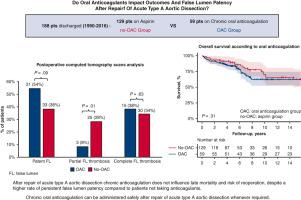The Journal of Thoracic and Cardiovascular Surgery ( IF 6 ) Pub Date : 2021-09-14 , DOI: 10.1016/j.jtcvs.2021.09.009 Igor Vendramin 1 , Daniela Piani 1 , Andrea Lechiancole 1 , Nunzio Davide de Manna 1 , Sandro Sponga 1 , Michela Puppato 2 , Daniele Muser 3 , Uberto Bortolotti 1 , Ugolino Livi 4

|
Objective
The study objective was to analyze the effects of chronic oral anticoagulation on long-term outcomes after repair of type A acute aortic dissection and its influence on false lumen fate.
Methods
We studied 188 patients (median age, 62 years; 74% were male) who underwent repair of type A aortic dissection; patients receiving postoperative chronic oral anticoagulation (n = 59) were compared with those receiving antiplatelet therapy alone (n = 129).
Results
Median age was similar: 60 years (18-79 years; OAC group) versus 64 years (22-86; no-OAC group) (P = .11); patients taking anticoagulants were more frequently male (88% vs 67%, P = .003). After a median follow-up of 8.4 years (2 months to 30 years), 58 patients died, 18 of aortic-related causes, and 37 patients underwent aortic reintervention. After multivariable adjustment, anticoagulation showed no significant effect on long-term survival (hazard ratio, 0.85; 95% confidence interval, 0.41-1.76; P = .66) or risk of reintervention (hazard ratio, 0.55; 95% confidence interval, 0.27-1.15; P = .11). Analysis of 127 postoperative computed tomography scans showed a patent false lumen in 53% of anticoagulated patients versus 38% of nonanticoagulated patients (P = .09): partially thrombosed in 8% versus 28% (P = .01) and thrombosed in 39% versus 34% (P = .63), respectively. In patients with a control computed tomography, there were 6 late aortic-related deaths, 1 among anticoagulated patients and 5 in those who were not.
Conclusions
Chronic anticoagulation after repair of type A acute aortic dissection favors persistent late false lumen patency, which is not a risk factor for late mortality or reoperation. Chronic anticoagulation can be administered safely to patients with repaired type A acute aortic dissection regardless of its specific indication.
中文翻译:

口服抗凝剂会影响急性 A 型主动脉夹层修复术后的结果和假腔通畅吗?
客观的
研究目的是分析慢性口服抗凝药对 A 型急性主动脉夹层修复术后远期结局的影响及其对假腔命运的影响。
方法
我们研究了 188 名接受 A 型主动脉夹层修复术的患者(中位年龄 62 岁;74% 为男性);接受术后慢性口服抗凝治疗的患者 (n = 59) 与接受单独抗血小板治疗的患者 (n = 129) 进行了比较。
结果
中位年龄相似:60 岁(18-79 岁;OAC 组)与 64 岁(22-86 岁;无 OAC 组)(P = .11);服用抗凝血剂的患者更多是男性(88% 对 67%,P = .003)。在中位随访 8.4 年(2 个月至 30 年)后,58 名患者死亡,其中 18 名死于主动脉相关原因,37 名患者接受了主动脉再介入治疗。多变量调整后,抗凝治疗对长期生存(风险比 0.85;95% 置信区间 0.41-1.76;P = .66)或再干预风险(风险比 0.55;95% 置信区间 0.27)没有显着影响-1.15;P = .11). 对 127 例术后计算机断层扫描的分析显示,53% 的抗凝患者和 38% 的非抗凝患者存在明显的假腔 ( P = .09):8% 对 28% ( P = .01) 部分血栓形成,39% 血栓形成分别为 34% ( P = .63)。在进行对照计算机断层扫描的患者中,有 6 例晚期主动脉相关死亡,其中 1 例发生在接受抗凝治疗的患者中,5 例发生在未接受抗凝治疗的患者中。
结论
A 型急性主动脉夹层修复后的慢性抗凝有利于持续的晚期假腔通畅,这不是晚期死亡或再次手术的危险因素。慢性抗凝治疗可以安全地用于 A 型急性主动脉夹层修复术后的患者,无论其具体指征如何。


























 京公网安备 11010802027423号
京公网安备 11010802027423号